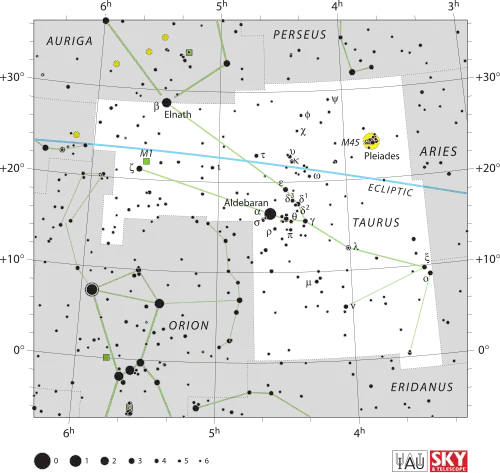Sigma2 Tauri
| Observation data Epoch J2000.0 Equinox J2000.0 (ICRS) | |
|---|---|
| Constellation | Taurus |
| Right ascension | 04h 39m 16.50230s[1] |
| Declination | +15° 55′ 04.7029″[1] |
| Apparent magnitude (V) | 4.70[2] |
| Characteristics | |
| Spectral type | A5 Vn[3] |
| U−B color index | +0.13[2] |
| B−V color index | +0.14[2] |
| Astrometry | |
| Radial velocity (Rv) | +40.8±1.2[4] km/s |
| Proper motion (μ) | RA: +83.17[1] mas/yr Dec.: −20.97[1] mas/yr |
| Parallax (π) | 20.97±0.27 mas[1] |
| Distance | 156 ± 2 ly (47.7 ± 0.6 pc) |
| Details | |
| Mass | 1.71[5] M☉ |
| Radius | 1.9[6] R☉ |
| Luminosity | 22.5[7] L☉ |
| Surface gravity (log g) | 3.96[5] cgs |
| Temperature | 8,165±278[5] K |
| Metallicity [Fe/H] | 0.10±0.11[8] dex |
| Rotational velocity (v sin i) | 128[3] km/s |
| Age | 258[5] Myr |
| Other designations | |
| 92 Tauri, BD+15°666, FK5 2345, HD 29488, HIP 21683, HR 1479, SAO 94054, WDS J04393+1555A[9] | |
| Database references | |
| SIMBAD | data |
Sigma2 Tauri (σ2 Tauri) is the Bayer designation for a white-hued star in the zodiac constellation of Taurus. It has an apparent visual magnitude of +4.70,[2] which indicates it is visible to the naked eye. Based upon parallax measurements, σ2 Tauri is about 156 light-years distant.
σ2 Tauri is a solitary[10] A-type main sequence star with a stellar classification of A5 Vn.[3] The 'n' suffix indicates the lines are "nebulous" due to rapid rotation, and indeed it is spinning with a projected rotational velocity of 128 km/s.[3] The star is an estimated 258[5] million years old, with 1.7[5] times the mass of the Sun. It is radiating 22.5[7] times the Sun's luminosity from its photosphere at an effective temperature of around 8,165 K.[5] The star is considered a member of the Hyades cluster.[6]
In Chinese astronomy, σ2 Tauri is called 附耳, Pinyin: Fùěr, meaning Whisper, because this star is marking itself and stands alone in the Whisper asterism of the Net mansion (see: Chinese constellation).[11]
References
- ^ a b c d e van Leeuwen, F. (2007), "Validation of the new Hipparcos reduction", Astronomy and Astrophysics, 474 (2): 653–664, arXiv:0708.1752, Bibcode:2007A&A...474..653V, doi:10.1051/0004-6361:20078357, S2CID 18759600.
- ^ a b c d Johnson, H. L.; et al. (1966), "UBVRIJKL photometry of the bright stars", Communications of the Lunar and Planetary Laboratory, 4 (99): 99, Bibcode:1966CoLPL...4...99J.
- ^ a b c d Royer, F.; et al. (February 2007), "Rotational velocities of A-type stars. III. Velocity distributions", Astronomy and Astrophysics, 463 (2): 671–682, arXiv:astro-ph/0610785, Bibcode:2007A&A...463..671R, doi:10.1051/0004-6361:20065224, S2CID 18475298.
- ^ de Bruijne, J. H. J.; Eilers, A.-C. (October 2012), "Radial velocities for the HIPPARCOS-Gaia Hundred-Thousand-Proper-Motion project", Astronomy & Astrophysics, 546: 14, arXiv:1208.3048, Bibcode:2012A&A...546A..61D, doi:10.1051/0004-6361/201219219, S2CID 59451347, A61.
- ^ a b c d e f g David, Trevor J.; Hillenbrand, Lynne A. (2015), "The Ages of Early-Type Stars: Strömgren Photometric Methods Calibrated, Validated, Tested, and Applied to Hosts and Prospective Hosts of Directly Imaged Exoplanets", The Astrophysical Journal, 804 (2): 146, arXiv:1501.03154, Bibcode:2015ApJ...804..146D, doi:10.1088/0004-637X/804/2/146, S2CID 33401607.
- ^ a b Pasinetti Fracassini, L. E.; et al. (February 2001), "Catalogue of Apparent Diameters and Absolute Radii of Stars (CADARS)", Astronomy and Astrophysics, 367 (Third ed.): 521–524, arXiv:astro-ph/0012289, Bibcode:2001A&A...367..521P, doi:10.1051/0004-6361:20000451, S2CID 425754.
- ^ a b McDonald, I.; et al. (2012), "Fundamental Parameters and Infrared Excesses of Hipparcos Stars", Monthly Notices of the Royal Astronomical Society, 427 (1): 343–57, arXiv:1208.2037, Bibcode:2012MNRAS.427..343M, doi:10.1111/j.1365-2966.2012.21873.x, S2CID 118665352.
- ^ Soubiran, C.; et al. (June 2010), "The PASTEL catalogue of stellar parameters", Astronomy and Astrophysics, 515: A111, arXiv:1004.1069, Bibcode:2010A&A...515A.111S, doi:10.1051/0004-6361/201014247, S2CID 118362423.
- ^ "sig02 Tau". SIMBAD. Centre de données astronomiques de Strasbourg. Retrieved 2017-08-06.
{{cite web}}: CS1 maint: postscript (link) - ^ Eggleton, P. P.; Tokovinin, A. A. (September 2008), "A catalogue of multiplicity among bright stellar systems", Monthly Notices of the Royal Astronomical Society, 389 (2): 869–879, arXiv:0806.2878, Bibcode:2008MNRAS.389..869E, doi:10.1111/j.1365-2966.2008.13596.x, S2CID 14878976.
- ^ (in Chinese) AEEA (Activities of Exhibition and Education in Astronomy) 天文教育資訊網 2006 年 5 月 23 日 Archived 2014-02-26 at the Wayback Machine
